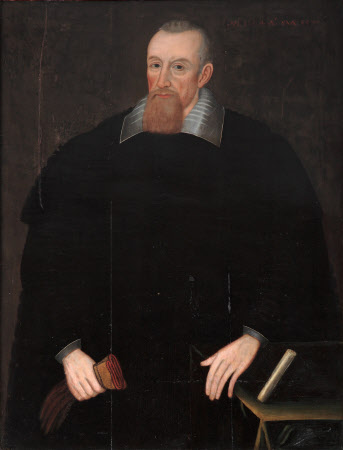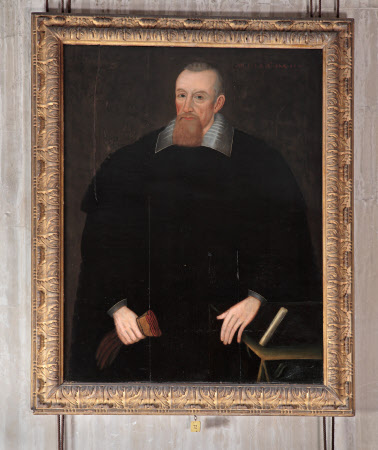Edward Bruce, 1st Lord Bruce of Kinloss (1548-1611), aged 55
British (English) School
Category
Art / Oil paintings
Date
1604 (inscribed)
Materials
Oil on three oak panels
Measurements
1100 x 830 mm
Order this imageCollection
Hardwick Hall, Derbyshire
NT 1129164
Caption
Edward Bruce prospered as an advocate, then judge, and in 1583 was granted the Abbey of Kinloss, of which he was made a free baron in 1601. He was used as an emissary by James VI to the court of Elizabeth I, and accompanied the King to England in 1603.
Summary
Oil painting on three oak panels, Edward Bruce, 1st Lord Kinloss (1548 - 1611), British (English) School, inscribed top right: ANo 1604 Æt SVÆ 55. A three-quarter length portrait, turned slightly to left, gazing at spectator, dressed in black with a white lawn collar, his gloves in his right hand, his left resting on a table, short receding hair and spade-shaped reddish beard and moustache. The sitter was the second son of Sir Edward Bruce of Blairhall, Clackmannan, Edward Bruce prospered as an advocate, then judge, and in 1583 was granted the Abbey of Kinloss to hold in commendam, of which he was made a free baron in 1601. Thrice used as an emissary by James VI to the court of Elizabeth I, he accompanied the King to England in 1603 and was made Master of the Rolls, in succession to Thomas Egerton. In 1608 he was made Baron Bruce of Kinloss, with a remainder firstly to the heirs male of his body, and then to his heirs and assigns. His eldest surviving son, Edward, 2nd Lord Kinloss and Lord Bruce of Kinloss, was killed in a duel with Edward Sackville, later 4th Earl of Dorset, at Bergen-op-Zoom in 1613. His next son, Thomas, was created 1st Earl of Elgin in 1633. The latter's son by his first wife, Anne Chichester, was created Earl of Ailesbury in 1664; his second wife was Diana Cecil, widowed Countess of Oxford. His only daughter, Christian (died 1674), married William Cavendish, later 2nd Earl of Devonshire, in 1608 - whence, no doubt, the presence of this picture at Hardwick. The King himself gave the bride away, and made her fortune up to £10,000.
Provenance
In Louisa C. Cavendish, 1860 catalogue; by descent until, following the death of the 10th Duke of Devonshire (1895 - 1950), Hardwick Hall and its contents were accepted by HM Treasury in part payment of death duties and transferred to the National Trust, in 1959
Credit line
Hardwick Hall, The Devonshire Collection (acquired through the National Land Fund and transferred to The National Trust in 1959)
Marks and inscriptions
top right ANo 1604 Aes Svae 55
Makers and roles
British (English) School, artist

